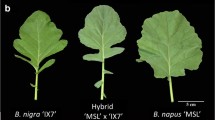Abstract
Genomic in situ hybridization (GISH) was used to examine genome interactions in two allohexa ploid (2n=6x=72) Lycopersicon esculentum (+) L. peruvianum somatic hybrids and their seed progenies originated from subsequent backcrosses to L. esculentum. The ability of GISH to distinguish between chromatin derived from two closely related species, L. esculentum and L. peruvianum (both 2n=2x=24), allowed the precise chromosomal constitution of somatic hybrids and their backcross progenies to be unequivocally established. This enabled the interaction of species genomes to be observed at meiosis, providing clear evidence of strictly regular homoeologous pairing and the high degree of homoeologous recombination in allodiploid plants (2n=2x=24) of the BC1 generation. In segmental allodiploids of the BC2 and BC3 generations, the recombinant chromosomes continued to pair with a homoeologous partner (in the absence of a homologous one), and therefore could be stably incorporated into gametes. Chiasmata were found almost exclusively in more distal, rather subterminal, chromosome segments. A considerable proportion of meiotic recombination was detected in subterminal heterochromatic regions, often involving distal euchromatin, located in close proximity. GISH also supplied information on the extent of the overall sequence homology between the genomes of L. esculentum and L. peruvianum, indicating that despite their different breeding systems, these species may not be differentiated to a high degree genetically. The present study has demonstrated that somatic hybridization between two such closely related, but sexually incompatible or difficult to cross species, provides a way of transferring genes, via homoloeogous crossing-over and recombination, across the incompatibility barriers. Indeed, such hybrids may offer the preferred route for gene transfer, which subsequently results in more stable gene introgression than other methods.
Similar content being viewed by others
Author information
Authors and Affiliations
Additional information
Received: 22 July 1996 / Accepted: 23 August 1996
Rights and permissions
About this article
Cite this article
Parokonny, A., Marshall, J., Bennett, M. et al. Homoeologous pairing and recombination in backcross derivatives of tomato somatic hybrids [Lycopersicon esculentum (+) L. peruvianum]. Theor Appl Genet 94, 713–723 (1997). https://doi.org/10.1007/s001220050470
Issue Date:
DOI: https://doi.org/10.1007/s001220050470




